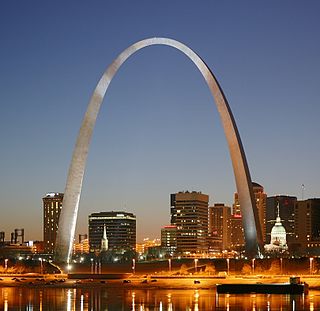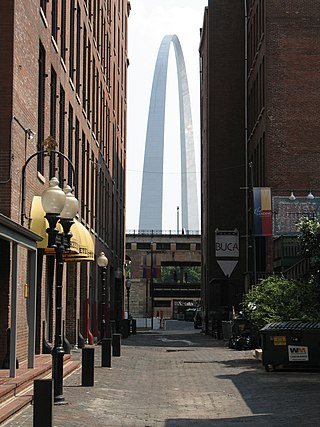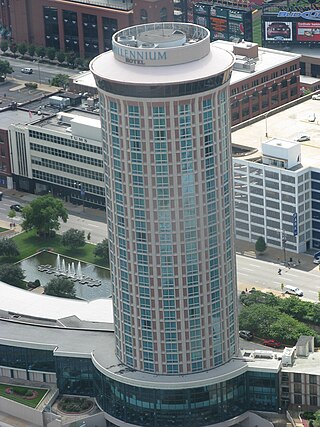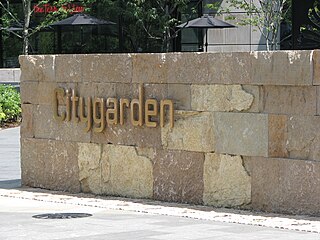Related Research Articles

St. Louis is an independent city in the U.S. state of Missouri. It is located near the confluence of the Mississippi and the Missouri rivers. In 2020,the city proper had a population of 301,578,while its metropolitan area,which extends into Illinois,had an estimated population of over 2.8 million. It is the largest metropolitan area in Missouri and the second-largest in Illinois. The city's combined statistical area is the 20th-largest in the United States.

Gateway Arch National Park is an American national park located in St. Louis,Missouri,near the starting point of the Lewis and Clark Expedition.

The Gateway Arch is a 630-foot-tall (192 m) monument in St. Louis,Missouri,United States. Clad in stainless steel and built in the form of a weighted catenary arch,it is the world's tallest arch and Missouri's tallest accessible structure. Some sources consider it the tallest human-made monument in the Western Hemisphere. Built as a monument to the westward expansion of the United States and officially dedicated to "the American people",the Arch is a National Historic Landmark in Gateway Arch National Park and has become a popular tourist destination,as well as an internationally recognized symbol of St. Louis.
The history of St. Louis began with the settlement of the area by Native American mound builders who lived as part of the Mississippian culture from the 9th century to the 15th century,followed by other migrating tribal groups. Starting in the late 17th century,French explorers arrived. Spain took over in 1763 and a trading company led by Pierre Laclede and Auguste Chouteau established the settlement of St. Louis in February 1764. It attracted French settlers leaving Illinois after their defeat in the Seven Years' War. The city grew in population due to its location as a trading post on the Mississippi River,as the western fur trade was lucrative. The city played a small role in the American Revolutionary War and became part of the U.S. through the Louisiana Purchase in 1803.

The architecture of St. Louis exhibits a variety of commercial,residential,and monumental architecture. St. Louis,Missouri is known for the Gateway Arch,the tallest monument constructed in the United States. Architectural influences reflected in the area include French Colonial,German,early American,European influenced,French Second Empire,Victorian,and modern architectural styles.
This is a list of properties and historic districts on the National Register of Historic Places within the city limits of St. Louis,Missouri,south of Interstate 64 and west of Downtown St. Louis. For listings in Downtown St. Louis,see National Register of Historic Places listings in Downtown and Downtown West St. Louis. For those north of I-64 and west of downtown,see National Register of Historic Places listings in St. Louis north and west of downtown. For listings in St. Louis County and outside the city limits of St. Louis,see National Register of Historic Places listings in St. Louis County,Missouri.

The Millennium Hotel St. Louis,more commonly known simply as the Millennium Hotel,is a defunct hotel complex in downtown St. Louis,Missouri that closed in 2014. The lower complex consisted of a plaza and several recreational facilities. Two towers,Millennium Hotel Tower I and Millennium Hotel Tower II,made up the hotel space. Tower I is 28 stories tall and was constructed in 1968. Tower II is 11 stories tall and was constructed in 1974. The building is adjacent to the Gateway Arch. The hotel had 780 rooms and 19 suites. It also featured a revolving restaurant called "Top of the Riverfront" on the 28th floor of Tower I.

The Gateway Mall in St. Louis,Missouri is an open green space running linearly,one block wide,from the Gateway Arch at Memorial Drive to Union Station at 20th Street. Located in the city's downtown,it runs between Market Street and Chestnut Street.
The numbered streets of St. Louis,Missouri generally run north–south through the city,starting with 1st Street at the Mississippi River,and increasing in value the further west they are. 1st through 25th Streets are primarily centered around the Downtown and Downtown West neighborhoods,with many extending further north and south into other neighborhoods. There are a few other higher value streets that appear elsewhere in the St. Louis area,and although they are not adjacent to the 1st–25th grid in the eastern part of the city,their numberings in relation to their distances from the river are relatively consistent.

The National Building Arts Center (NBAC) is a large collection of architectural,structural,and industrial items on a 12.5-acre (5.1 ha) site in Sauget,Illinois. The collection,thought to be the largest amount of architectural artifacts in the United States,is the physical collection of the St. Louis Building Arts Foundation.
The streets of St. Louis,Missouri,United States,and the surrounding area of Greater St. Louis are under the jurisdiction of the City of St. Louis Street Department. According to the department's Streets Division,there are 1,000 miles (1,600 km) of streets and 600 miles (970 km) of alleys within the city.

Citygarden is an urban park and sculpture garden in St. Louis,Missouri owned by the City of St. Louis but maintained by the Gateway Foundation. It is located between Eighth,Tenth,Market,and Chestnut streets,in the city's "Gateway Mall" area. Before being converted to a garden and park,the site comprised two empty blocks of grass. Citygarden was dedicated on June 30,2009,and opened one day later,on July 1,2009.
The history of St. Louis,Missouri from 1981 to the present has been marked by city beautification and crime prevention efforts,a major school desegregation case,and gentrification in its downtown area. St. Louis also continues to struggle with crime and a declining population,although some improvement has been made in both of these aspects.

The 1992 Missouri gubernatorial election was held on November 3,1992 and resulted in a victory for the Democratic nominee,Lt. Governor Mel Carnahan,over the Republican candidate,Missouri Attorney General William L. Webster,and Libertarian Joan Dow. Carnahan had defeated St. Louis mayor Vincent C. Schoemehl for the Democratic nomination,while Webster had defeated Secretary of State Roy Blunt and Treasurer Wendell Bailey for the Republican nomination.

The 2017 St. Louis mayoral election was held on April 4,2017,to elect the mayor of St. Louis,Missouri. Incumbent Mayor Francis Slay chose not to run for reelection. Slay,who was serving his fourth term as mayor,indicated in March 2016 that he would run for reelection,but announced in April 2016 that he would not run for a fifth term. Primary elections took place on March 7,2017,and the general election was held on April 4. Alderwoman Lyda Krewson was elected and became the first female Mayor of St. Louis.

Lyda Krewson is an American retired politician who was the 46th mayor of St. Louis,Missouri. She is a member of the Democratic Party and St. Louis's first female mayor,serving from 2017 to 2021. On November 18,2020,Krewson announced that she would not seek a second term.

The 2024 United States Senate election in Missouri will be held on November 5,2024,to elect a member of the United States Senate to represent the state of Missouri. Republican incumbent Josh Hawley is seeking a second term. He is being challenged by Democratic attorney Lucas Kunce. Primary elections took place on August 6,2024.
The Club Imperial was a nightclub at 6306-28 West Florissant Ave in St. Louis,Missouri. During the club's heyday in the 1950s through the 1960s,acts such as Ike &Tina Turner,Chuck Berry,and Bob Kuban and the In-Men performed at the Club Imperial.

Cara Spencer is an American politician from the state of Missouri. She serves on the St. Louis Board of Aldermen as alderwoman of Ward 8,having previously represented Ward 20 from 2015-2023. Spencer ran in the 2021 St. Louis mayoral election,finishing as a top-two candidate in the primary election. She lost in the general election to Tishaura Jones.
References
- ↑ https://www.youtube.com/watch?v=d_AwsOOFujE [ bare URL ]
- ↑ "Rudy Bruner Award for Urban Excellence". Selection Committees. Bruner Foundation. Archived from the original on 7 January 2014. Retrieved 7 January 2014.
- ↑ Holleman, Joe. "Spotlight: Building interrupting the Gateway Mall is a mayor's regret". stltoday.com. Retrieved 2019-05-03.
- ↑ "The Evolution of the Gateway Mall (Part 7): "Pride" and the Mall | Preservation Research Office" . Retrieved 2019-05-03.
- ↑ Guenther, Robert (Jul 21, 1982). "Plans for Park-Like Mall Stir Battle in Downtown St. Louis". Wall Street Journal. p. 31.
- ↑ "Built St. Louis | Historic Downtown". www.builtstlouis.net. Retrieved 2019-05-03.
- ↑ Bose, Richard (2014-03-13). "Street not Thru: The Cul-De-Sacking of St. Louis". NextSTL. Retrieved 2019-05-03.
- ↑ "TENT CITY RETURNS TO CITY HALL". St. Louis Post-Dispatch. 2 July 1988. p. 4A.
- ↑ O'Neil, Tim; Bertelson, Christine (3 July 1990). "VISIBLE TENT CITY IS USED TO REMIND AREA OF HOMELESSNESS". St. Louis Post-Dispatch. p. 1A.
- ↑ Staff (July 25, 2007). "Blunt appoints Schoemehl to Bi-State Development Agency". St. Louis Business Journal. Retrieved August 19, 2016.
- ↑ Wilson, D. J. "Demolition Man". Riverfront Times. Retrieved 2019-05-03.
- ↑ "School Board Might Censure Schoemehl Today". news.stlpublicradio.org. Retrieved 2019-05-03.
- ↑ "Best Villain". Riverfront Times. Retrieved 2019-05-03.
- April 17, 2006: Interview from MayorSlay.com for 25th Anniversary of Mayor Schoemehl's inauguration.
- "New Mayor in St. Louis". Burlington Hawk-Eye. April 22, 1981. p. 2.
- Holleman, Joe; Schlinkmann, Mark (April 21, 1993). "Bosley Takes Reins of City Hall". St. Louis Post-Dispatch. p. 1A.